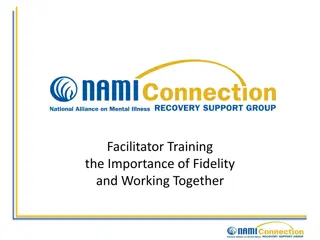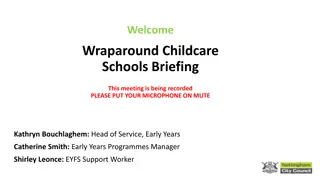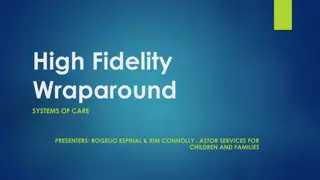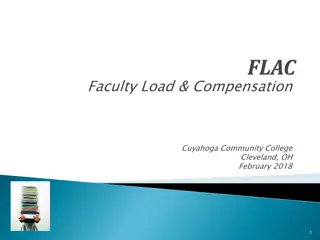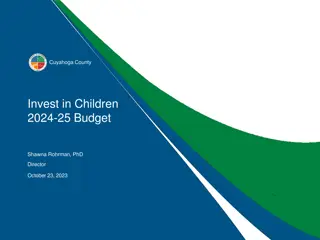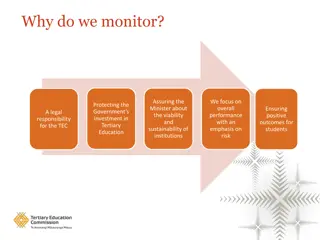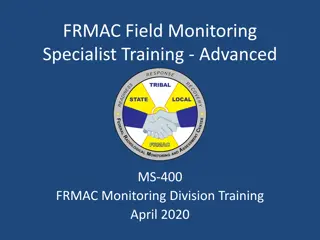Analysis of Wraparound Fidelity Monitoring in Cuyahoga County
The analysis focuses on the Wraparound Fidelity Monitoring in Cuyahoga County, examining the progress and outcomes in quality assurance efforts. Key aspects include the effectiveness of teamwork, community supports, needs-based approaches, outcomes-driven strategies, and family-driven practices. The data shows comparisons with national means and highlights the importance of system-level outcomes in the context of wraparound services.
Download Presentation

Please find below an Image/Link to download the presentation.
The content on the website is provided AS IS for your information and personal use only. It may not be sold, licensed, or shared on other websites without obtaining consent from the author.If you encounter any issues during the download, it is possible that the publisher has removed the file from their server.
You are allowed to download the files provided on this website for personal or commercial use, subject to the condition that they are used lawfully. All files are the property of their respective owners.
The content on the website is provided AS IS for your information and personal use only. It may not be sold, licensed, or shared on other websites without obtaining consent from the author.
E N D
Presentation Transcript
Hope is the thing with feathers - That perches in the soul- And sings the tune without the words - And never stops - at all - Emily Dickinson
Progress on Quality Assurance: Cuyahoga County Wraparound Jane Timmons-Mitchell, Ph.D. Targeted RECLAIM Oct. 26, 2018
Fidelity Monitoring in Wraparound In Cuyahoga County, Wraparound Fidelity has been monitored for 6 agencies as part of a project with the Department of Children and Family Services The Wraparound Fidelity Index v. 4, WFI-EZ, is a brief instrument completed by caregivers, facilitators, and youth enrolled 60 days or more. The WFI-EZ contains four parts: fidelity, system level outcomes, functioning outcomes, and satisfaction. In addition, recidivism outcomes for Wraparound involved youth were analyzed.
Wraparound Fidelity The WFI-EZ fidelity scoring is derived from endorsing 25 items using a 5 point Likert type scale which is scored from 0 to 4. Items load into five domains, including Effective Teamwork, Natural Supports, Needs-based, Outcomes- based, and Strength and Family Driven. Examples of items include: Our wraparound team s decisions are based on input from me and my family At every team meeting, my wraparound team reviews progress that has been made toward meeting our needs. At each team meeting, our wraparound team celebrates at least one success or positive event. Members of our wraparound team sometimes do not do the tasks they are assigned. Because of wraparound, when a crisis happens, my family and I know what to do.
Effective Teamwork Natural/ Community Supports Needs Based Outcomes Based Strength/ Family Driven Total 78.5% 76.4% 71.3% 79.7% 82.4% 82.8% Cuyahoga County 72.0% National Mean 67.8% 65.6% 73.8% 75.3% 77.6%
Cuyahoga County WFI-EZ Scores Compared with National Mean 90 80 70 60 50 40 30 20 10 0 Effective Teamwork Natural/Community Supports Needs Based Outcomes Based Strength/Family Driven Total Cuyahoga County National Mean
System Level Outcomes The outcomes domain is measured by yes/no questions for the system level outcomes; endorsement of these items can be interpreted as percents.
WFI-EZ System Level Outcomes Item Level Means National Mean 0.20 0.21 D1. Since starting wraparound, my child or youth has had a new placement in an institution (such as detention, psychiatric hospital, treatment center, or group home) D2. Since starting wraparound, my child or youth has been treated in an Emergency Room due to a mental health problem D3. Since starting wraparound, my child or youth has had a negative contact with police D4. Since starting wraparound, my child or youth has been suspended or expelled from school Note. The data is derived from 70 Caregiver forms and 74 Care Coordinator forms for a total of 144 forms. 0.11 0.13 022 0.21 0.35 0.24
WFI-EZ System Level Outcomes 0.4 0.35 0.35 0.3 0.24 Item level means 0.25 0.22 0.21 0.21 0.2 0.2 0.15 0.13 0.11 0.1 0.05 0 placement ER police school Tapestry National Mean
Functioning Outcomes Functioning outcomes are measured using a 4 point Likert type scale ranging from 0 through 3, and questions measuring satisfaction outcomes use a 5 point Likert type scale ranging from 0 through 4.
WFI-EZ Functioning Outcomes WFI-EZ Functioning Outcomes Item Level Means Item Level Means National Mean 0.92 1.42 D6. Problems that disrupt home life 1.10 1.24 D7. Problems that interfere with success at school 0.71 1.07 D8. Problems that make it difficult to develop or maintain friendships 0.71 0.96 D9. Problems that make it difficult to participate in community activities. Note. The data is derived from 70 Caregiver forms and 74 Care Coordinator forms for a total of 144 forms.
WFI-EZ Functioning Outcomes WFI-EZ Functioning Outcomes 1.6 1.42 1.4 1.24 1.17 1.2 1.1 1.07 Item Level Means 0.96 1 0.92 0.8 0.71 0.6 0.4 0.2 0 Disruption-home School Friendships Activities Tapestry National Mean
Caregiver Satisfaction Caregivers are asked to rate, from Strongly Agree to Strongly Disagree, how satisfied they are with Wraparound services based on the items.
WFI-EZ Satisfaction Item Level Means Item Level Means 1.52 National Means 1.29 C1. I am satisfied with the wraparound process in which my family and I have participated C2. I am satisfied with my child or youth's progress since starting the wraparound process 1.25 1.09 C3. Since starting wraparound, our family has made progress toward meeting our needs 1.32 1.07 C4. Since starting wraparound, I feel more confident about my ability to care for my child/youth at home 1.32 1.08 Note. The data is derived from 71 Caregiver forms.
WFI-EZ Satisfaction per Caregiver 1.6 1.52 1.4 1.32 1.32 1.29 1.25 1.2 1.09 1.08 1.07 Item level means 1 0.8 0.6 0.4 0.2 0 Process Youth Progress Family Progress Condfident Tapestry National Mean
Juvenile Justice Outcomes A total of 849 clients were included in this analysis, including 781 clients in the Wraparound and 68 in the comparison group (referred but not engaged) compared on time from disenrollment to first recidivism using the log-rank test. Kaplan-Meier and Cox proportional hazards regression were calculated.
Juvenile Justice Outcome The mean time from discharge to recidivism was 826 days (standard deviation: 22 days) in the Wraparound group and 534 days (standard deviation: 50 days) in the comparison group. Overall, the time from disenrollment to recidivism was statistically significantly longer (better) in the Wraparound group than in the comparison group Of youth with new charges, 70% were misdemeanors and 30% were felonies
Beginning at 9 months after discharge, recidivism was significantly lower in the group that received High Fidelity Wraparound. Log-rank test P-value = 0.0003,
Fidelity is often a good predictor of outcome BUT it can take a long time to establish Outcomes. By monitoring Fidelity, you can approximate outcomes that you will eventually be able to track.



